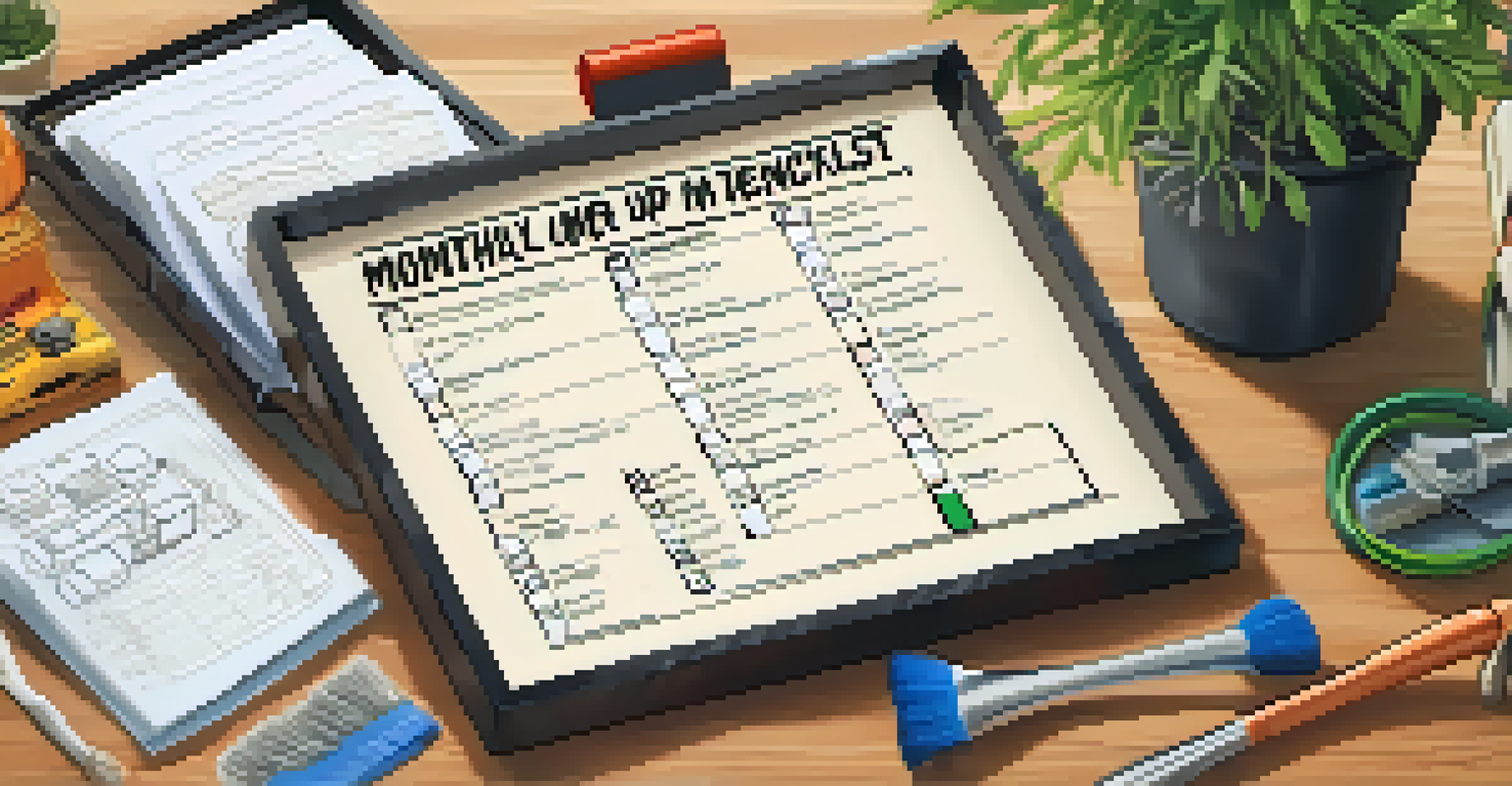Monthly Home Maintenance Planner: Stay Organized and Ahead

Understanding the Importance of Monthly Home Maintenance
Regular home maintenance is essential for preserving your property's value. Just like a car, your home requires routine checks to function efficiently and avoid costly repairs down the line. A monthly maintenance plan can help you stay organized and ensure you’re not overlooking critical tasks.
An ounce of prevention is worth a pound of cure.
Think of your home as a living entity that needs attention and care. By dedicating a bit of time each month, you can tackle simple tasks that prevent bigger, more expensive issues from arising. This proactive approach saves you stress and money in the long run.
Moreover, staying on top of home maintenance can enhance your living experience. A well-maintained home is not only more enjoyable but also safer. Creating a monthly planner is a great way to keep track of everything that needs attention and make sure you’re prepared for the seasons ahead.
Creating Your Monthly Maintenance Checklist
To kick off your monthly home maintenance journey, start by creating a checklist tailored to your home. This can include tasks like changing air filters, checking smoke detectors, and inspecting your roof for damage. A comprehensive checklist will ensure you cover all bases and can be customized according to your specific needs.

Consider organizing your checklist by seasons or areas of your home. For instance, tasks such as gutter cleaning might be more relevant in the fall, while HVAC inspections are ideal in spring. This way, you can distribute your workload evenly throughout the year, making maintenance less overwhelming.
Monthly Maintenance Preserves Value
Regular home maintenance helps maintain your property's value and prevents costly repairs.
You can also use apps or tools to help you manage your checklist digitally. These can send you reminders when tasks are due or allow you to track completed jobs, giving you a sense of accomplishment as you go along. The key is to make it as convenient as possible to integrate into your routine.
Monthly Tasks for the Interior of Your Home
Every month, there are several tasks you can focus on inside your home. These may include cleaning appliances, checking for leaks under sinks, or dusting ceiling fans. By regularly addressing these areas, you can maintain a clean and efficient living space.
The bitterness of poor quality remains long after the sweetness of low price is forgotten.
Another essential interior task is checking your home’s air quality. This can involve changing air filters, cleaning vents, and even testing for carbon monoxide. A healthy home environment is vital for your overall well-being, so prioritizing these checks is crucial.
Don’t forget about organizing and decluttering as part of your monthly routine. A tidy space not only looks better but also reduces stress and makes it easier to find what you need. A clutter-free home can significantly improve your quality of life.
Monthly Tasks for the Exterior of Your Home
Your home’s exterior also requires monthly attention to maintain its curb appeal and structural integrity. Start with tasks like inspecting your siding for wear and tear or cleaning your windows. These simple steps can prevent long-term damage and keep your home looking its best.
Another important exterior task is checking your landscaping. This might include trimming bushes, mowing the lawn, and checking for weeds. A well-maintained yard enhances your home’s appearance and can even increase its value if you decide to sell in the future.
Create a Personalized Checklist
Tailoring a monthly maintenance checklist ensures that all critical tasks are addressed systematically.
Don’t forget about outdoor features like decks and patios. Regularly inspect these areas for signs of wear, such as loose boards or rusted railings. Keeping these spaces safe and inviting will enhance your outdoor living experience.
Seasonal Considerations for Your Maintenance Planner
As you create your monthly planner, it’s crucial to consider seasonal changes. Each season brings different challenges, from winter snow to summer heat. Being aware of these factors allows you to adjust your maintenance tasks accordingly.
For instance, in the fall, you may want to focus on cleaning gutters and preparing your heating system for colder months. In the spring, checking for water damage and ensuring your air conditioning system is ready for the heat is vital. This seasonal approach keeps your home in peak condition year-round.
By planning tasks ahead of time based on the seasons, you can avoid last-minute rushes and ensure that everything is taken care of at the right time. This foresight not only keeps your home safe but also gives you peace of mind.
Budgeting for Home Maintenance: Costs to Consider
One aspect of home maintenance that’s often overlooked is budgeting. Regular upkeep can incur costs, from purchasing cleaning supplies to hiring professionals for repairs. Setting aside a monthly budget for maintenance can help you manage these expenses without breaking the bank.
Consider creating a separate savings account specifically for home maintenance. This way, when unexpected repairs arise, you won’t be caught off guard. It’s like having a safety net that ensures your home stays in top shape without causing financial strain.
Budget for Maintenance Expenses
Setting a budget for home maintenance can help manage costs effectively and avoid financial strain.
Also, keep an eye out for DIY opportunities to save money. Many tasks, such as painting or basic landscaping, can be done by yourself with a little research and effort. The more you can handle on your own, the more you can allocate your budget to those bigger projects that require professional help.
Tracking Your Progress and Adjusting Your Planner
As you embark on your monthly maintenance journey, tracking your progress is key. Keeping a log of completed tasks can help you see how far you’ve come and identify areas that may need more attention. This can be as simple as a checklist or a digital app that allows you to check off tasks as you complete them.
Don’t hesitate to adjust your maintenance planner as you go. Maybe you find that certain tasks take longer than expected, or you discover new areas that require attention. Being flexible and willing to adapt your planner will help you stay organized and less overwhelmed.

Remember, the goal is to create a sustainable routine that works for you and your home. By tracking your progress and making necessary adjustments, you’ll develop a maintenance rhythm that keeps your home in excellent condition while fitting seamlessly into your lifestyle.